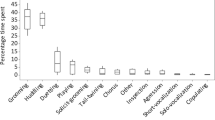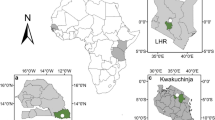Abstract
Studies were conducted on a captive group of 16 blackcapped capuchin monkeys (Cebus apella), with observations being carried out for a total of 75 hr over a 6 month period. Records were kept of their activities and spatial distribution according to weather type and time of day. Evidence of a social hierarchy was sought and was characterized primarily by the stability of the environment in which the animals live, dominance playing little part.
The behaviour of the blackcapped capuchin has been studied previously in captivity (Dobruruka, 1972;Weigel, 1979); this study is, however, unique in that the troop under observation enjoys more freedom. Weather had no effect on the rank order of behavioural activities but did affect both activity levels and distribution of individuals.
TheCebus apella troop spent around 50% of its active time foraging and eating, 7–10% of this time walking and around 30% of the time inactive. These values lie between those reported for caged and wild animals. Social interactions contributed more than 10% of the time budget, which is greater than wild populations. The study here thus provides an interesting link between information collected from wildCebus apella populations and that from rather more restricted troops.
Similar content being viewed by others
References
Altmann, J., 1974. Observational study of behaviour: Sampling Methods.Behaviour, 48: 1–41.
Bernstein, I. S., 1965. Activity patterns in aCebus monkey group.Folia Primatol., 3: 211–224.
, 1966. Analysis of a key role in a capuchin (Cebus albifrons) group.Tulane Stud. Zool., 13: 49–54.
, &W. A. Mason, 1964. Activity patterns of rhesus monkeys in a social group.Anim. Behav., 4: 455–460.
Clutton-Brock, T. H. &P. H. Harvey, 1977. Primate ecology and social organization.J. Zool., 183: 1–39.
Dobruruka, L. J., 1972. Social communication in the brown capuchin,Cebus apella.Int. Zoo. Yrbk., 12: 43–45.
Eisenberg, J. F., N. A. Muckenhirn, &R. Rudran, 1972. The relation between ecology and social structure in primates.Science, 176: 864–874.
Gartlan, J. S., 1968. Structure and function in primate society.Folia Primatol., 8: 89–120.
Izawa, K., 1978. Frog-eating behaviour of wild black-capped capuchin (Cebus apella).Primates, 19: 633–642.
, 1979. Foods and feeding behaviour of wild black-capped capuchin (Cebus apella).Primates, 20: 57–76.
, 1980. Social behaviour of the wild black-capped capuchin (Cebus apella).Primates, 31: 443–467.
Martin, I. D., 1981. Field studies of primate behaviour.Symp. Zool. Soc. London, 46: 287–336.
Oppenheimer, J. R., 1968. Behaviour and ecology of the white-faced monkey,Cebus capucinus on Barro, Colorado Island. Unpubl. Ph.D. thesis, Univ. of Illinois, Urbana.
&E. L. Oppenheimer, 1973. Preliminary observations ofCebus nigrivittatus (Primates: Cebidae) in the Venezuelan Ilanos.Folia Primatol., 19: 409–436.
Plotnik, R., F. A. King, &L. Roberts, 1968. Effects of competition on the agressive behaviour of squirrel andCebus monkeys.Behaviour, 29: 315–332.
Robinson, J. G., 1981. Spatial structure in foraging groups of wedge-capped capuchin monkeys,Cebus nigrivittatus.Anim. Behav., 29: 1036–1057.
----, 1985. Seasonal variation in use of time and space by the wedge-capped capuchin monkey,Cebus olivaceus: implications for foraging theory.Smiths. Contrib. Zool., No. 431.
Rowell, T. E., 1967. A quantitative comparison of the behaviour of a wild and a caged baboon group.Anim. Behav., 15: 499–509.
Sokal, R. R. &F. J. Rohlf, 1981.Biometry (2nd ed.). W. H. Freeman & Co., San Francisco.
Terborgh, J., 1983.Five New World Primates: A Study in Comparative Ecology. Princeton Univ. Press, Princeton, New Jersey.
Weigel, R. M., 1979. The facial expressions of the brown capuchin monkey (Cebus apella).Behaviour, 68: 250–276.
Zar, J. H., 1984.Biostatistical Analysis. Prentice Hall, New Jersey.
Author information
Authors and Affiliations
About this article
Cite this article
Ross, R.A., Giller, P.S. Observations on the activity patterns and social interactions of a captive group of blackcapped or brown capuchin monkeys (Cebus apella). Primates 29, 307–317 (1988). https://doi.org/10.1007/BF02380954
Received:
Accepted:
Issue Date:
DOI: https://doi.org/10.1007/BF02380954




